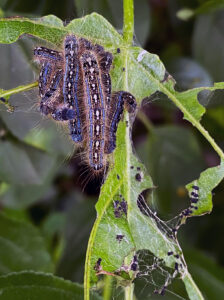
Forest tent caterpillar larvae displaying gregarious behavior and feeding on a tree leaf. / Photo Credit: Paul Cigan, Wisconsin DNR
By Paul Cigan, Wisconsin DNR Forest Health Specialist
Paul.Cigan@wisconsin.gov or 715-416-4920
Forest tent caterpillar (FTC) populations do not appear to be making a significant return this growing season.
Spring egg mass surveys indicate that populations continue to remain low, continuing the longest documented interphase between outbreaks on state record, at 22 years and counting. The interphase provides some relief for the health of aspen stands recovering from several consecutive years of recent spongy moth defoliation.
In Wisconsin, FTC is a native spring defoliator that prefers aspen, sugar maple and birch. The insect historically underwent regionwide outbreaks in the north at intervals of 6-16 years.
Defoliation during periods between outbreaks is typically localized and light in severity, usually going unobserved and unreported. During outbreaks, populations erupt and defoliate hundreds of thousands of acres for several consecutive years – and potentially defoliate more than several million acres in peak years.
Tree mortality can occur in drought-stressed stands following consecutive years of defoliation, often after attack by secondary tree diseases and insect pests (e.g., Armillaria root disease; bronze birch borer).
Spring weather conditions that are cooler and wetter than average cause reduced caterpillar population survival and growth by enhancing the activity of pathogenic fungi and slowing larval developmental rates.
Forest managers and forest landowners are advised to watch for and report defoliation for the remainder of this and coming years. FTC can be misidentified as other caterpillars, such as eastern tent caterpillar, fall webworm or spongy moth, so it’s important to correctly identify the insect of interest.
In particular, localized outbreaks of spongy moth may be present in northern Wisconsin in early July. Spongy moths’ preferred hosts include many of the same species preferred by FTC.
Please report any suspected FTC defoliation to your regional forest health specialist and learn more about FTC identification and biology on the DNR forest health webpage.
